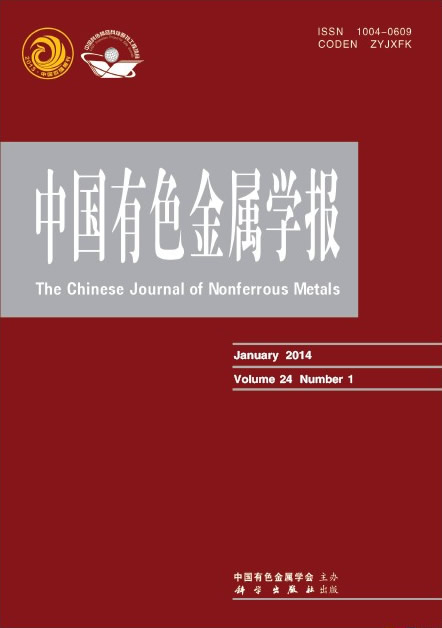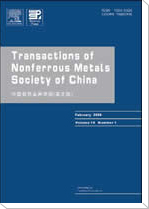(1. 兰州理工大学 省部共建有色金属先进加工与再利用国家重点实验室,兰州 730050;
2. 镍钴资源综合利用国家重点实验室,金昌 737100)
摘 要: 研究铜离子浓度对工业电解液中镍电结晶过程的影响。采用传统三电极体系,通过阴极极化法、循环伏安法、计时电流法分析铜离子对镍电结晶初期行为的影响。利用电位阶跃和霍尔槽实验制备沉积层并通过SEM观察其微观组织形貌,通过XRD分析其择优生长取向。结果表明:不同质量浓度铜离子的加入使得镍电结晶过电位降低,镍的起始沉积电位发生正移,但并不改变镍形核/长大的生长方式。铜离子的加入使镍形核弛豫时间tm逐渐缩短,峰电流Im逐渐增大;当铜离子质量浓度为0.5和1.0 g/L、阶跃电位为-0.85 V时,镍电结晶处于三维连续形核和三维瞬时形核之间;当阶跃电位处于-0.90~-1.00 V时,接近于三维瞬时形核。随着铜离子浓度增大到1.5 g/L、2.0 g/L时,镍电结晶由三维连续形核转变为三维瞬时形核;镍-铜电解液在电沉积过程中更适用于三维瞬时形核/生长机制。随着铜离子的引入,镍和铜发生共沉积,沉积层晶粒尺寸变大;沉积层的形貌由最初的小圆球颗粒逐渐变为金字塔状,生长方式以螺旋位错生长方式为主,晶粒逐渐由(111)面转变为(111)、(220)面生长。
关键字: 镍;工业电解液;铜离子;电结晶行为
(1. State Key Laboratory of Advanced Processing and Recycling of Non-ferrous Metal, Lanzhou University of Technology, Lanzhou 730050, China;
2. State Key Laboratory for Comprehensive Utilization of Nickel and Cobalt Resources, Jinchang 737100, China)
Abstract:In order to study the effect of different concentrations of copper ions on the electrocrystallization behavior of nickel in industrial electrolytes, the traditional three-electrode system was used to analyze the effect of copper ions on the initial behavior of nickel electrocrystallization through cathodic polarization, cyclic voltammetry and chronoamperometry. The microstructure morphology was observed by SEM using chronoamperometry and Hall cell experiment, and the preferred growth orientation was analyzed by XRD. The results show that the addition of copper ions with different mass concentrations decreases the electrocrystallization overpotential of nickel and the initial deposition potential of nickel shifts positively, which does not change the mode of nickel through the way of nucleation/growth. The addition of copper ions gradually reduces the nucleation relaxation time tm, and the peak current Im gradually increases. When the copper ion mass concentrations are 0.5 and 1.0 g/L, and the step potential is -0.85 V, nickel electrocrystallization is between the three-dimensional continuous nucleation and the three-dimensional instantaneous nucleation; when the step potential is -0.90--1.00 V, nickel electrocrystallization is close to instantaneous nucleation. As the copper ion concentration increases to 1.5 g/L and 2.0 g/L, nickel electrocrystallization changes from the three-dimensional continuous nucleation to the three-dimensional instant nucleation. Nickel-copper electrolyte is more suitable for three-dimensional instantaneous nucleation/growth mechanism during electrodeposition. With the introduction of different mass concentrations of copper ions, nickel and copper are co-deposited, the grain size becomes larger. The morphology of the sedimentary layer gradually changes from the original small spherical particles to pyramid shape, and the growth mode is still dominated by screw dislocation growth. The grain orientation changes from (111) plane to (111), (220) plane.
Key words: nickel; industrial electrolyte; copper ions; electrocrystallization behavior


